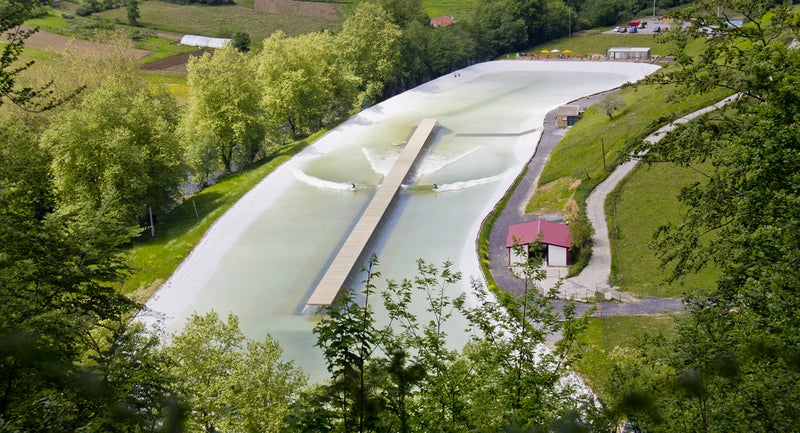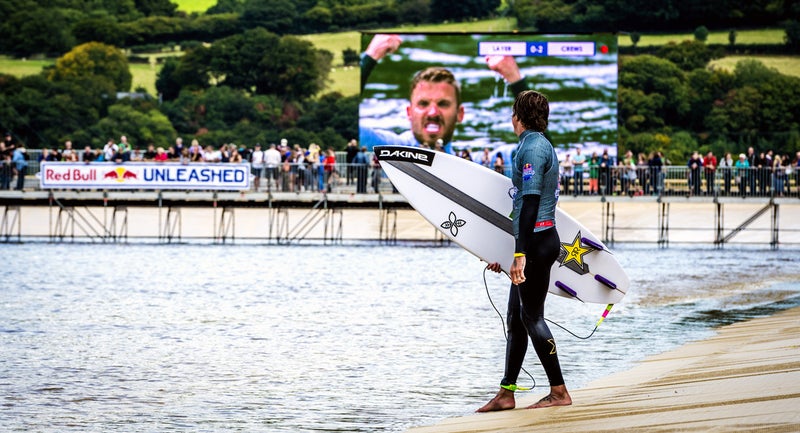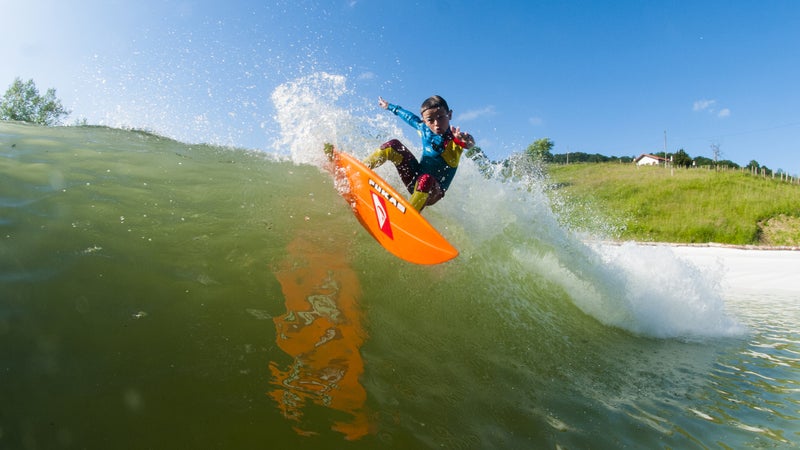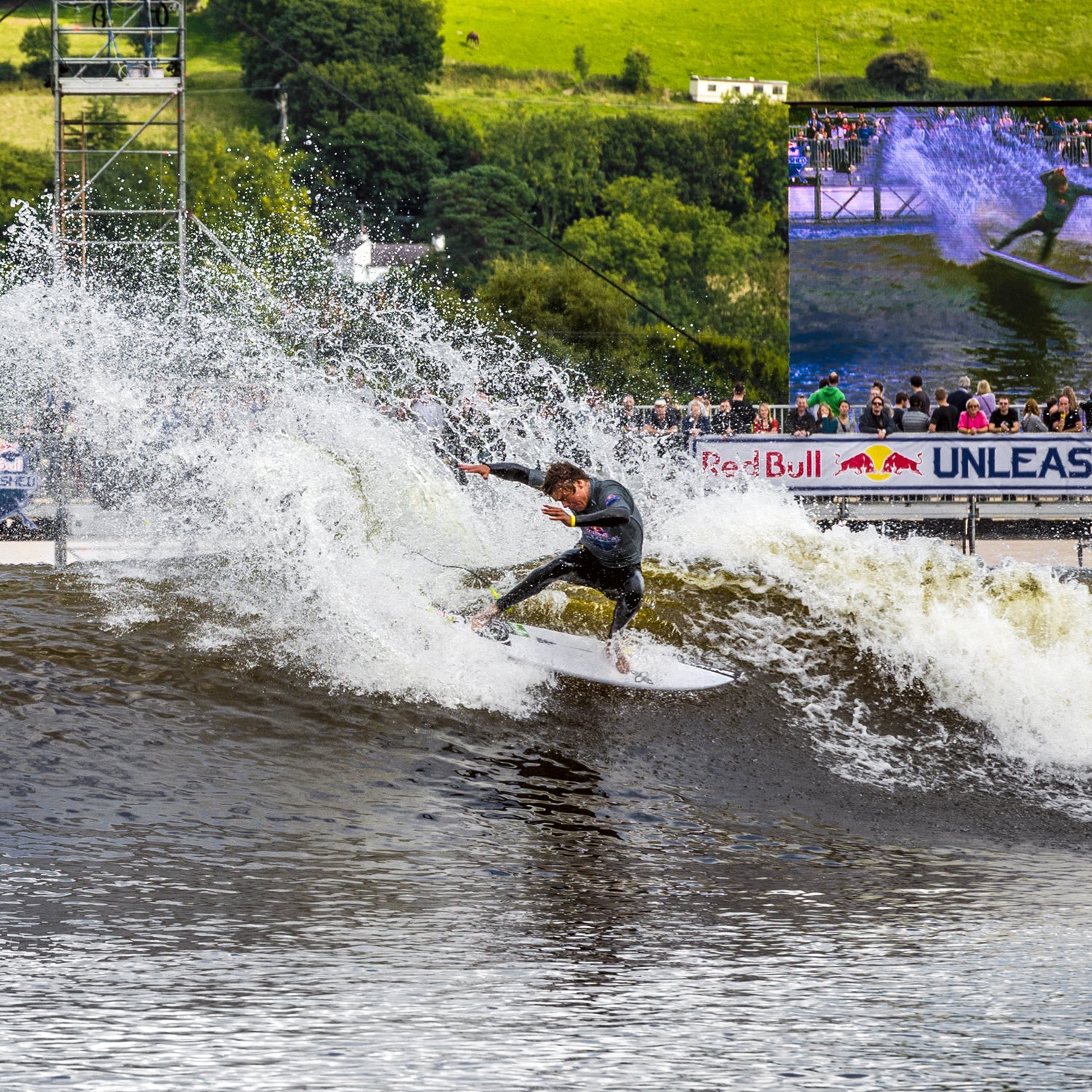It’s been a hot summer for wave pools.
In June, the artificial surf debate was reignited by the International Surfing Association’s announcement that surfing had been shortlisted for inclusion into the 2020 Tokyo Olympic Games. The decision was made based in part on the ISA’s promise that competition would be held in indoor arenas where waves can be manufactured for identical shape and size. “Wave pool technology will be very important in guaranteeing a meaningful and fair playing field for the top competitors to showcase their sport to the world,” ISA president, Fernando Aguerre, said at the time. This week, the Tokyo 2020 Organizing Committee agreed, recommending that the sport be included in the Games. (The IOC will have the final say next August, and it is likely to confirm the decision.)
The announcement comes on the heels of the most successful artificial wave event in competitive surfing history. The inaugural Red Bull Unleashed was held last month in North Wales at the brand new, $24 million adventure park, Surf Snowdonia, home of a man-made surf lagoon called the .

First, a quick lesson in how Wavegarden’s pool works. Have you ever stood in the shallow end of a swimming pool and swept your forearms through the water to send ripples across the surface? Creating surfable waves is similar. A large hydrodynamic blade, called a “wavefoil,” is drawn by a cable through the center of the lagoon—which is about the size of six football fields—just beneath the water’s surface at a rate of 20 feet per second. The wake produces a left- and right-breaking wave that is about chest-high and peels, rather perfectly, for well over a hundred yards. Those were the waves pro surfers rode at Red Bull Unleashed.
“The conditions for the final here were ten times better than they were at Trestles yesterday,” an Unleashed competitor, Kai Hing, last month, comparing the Wavegarden to the Southern California break where a World Surf League (WSL) event had just wrapped up. The wave at Trestles is considered one of the best in the world, and Hing’s comment brings up an question at the core of the wave pool proposition: Is there a measurable difference between fake waves and real ones?
The surfing-event experience is definitely different. With its grandstands, jumbotron, and pumping music, and given the sight of competitors completing runs on nearly identical waves, Red Bull Unleashed resembled more a vert event at the X-Games than, say, a traditional surf competition in Tahiti, which is sparsely attended. But what was missing in the Welsh countryside, and what will keep those conventional contests held in large waves like Tahiti from ever being dethroned, was one crucial element: raw oceanic power. Or, at least, the perception of it.

“The wave pool is so weak, and you’ve got to generate all of your own speed,” WSL surfer and Unleashed semi-finalist Mitch Crews . “But when there is a normal [ocean] wave all the speed comes from the wave, and you don’t have to do anything.”
Crews touches on a crucial, controversial point that echoes the ire many surfers feel toward wave pools and reflects their opposition to surfing in the Olympics: Artificial waves lack energy. But do they?
“From a scientific perspective, a wave pool wave and an ocean wave that are the same size have the same amount of energy in them,” says David Clark, an ocean physics and engineering scientist at Woods Hole Oceanographic Institution in Massachusetts. “Physically, there’s no difference.”
It is often said among surfers that waves which travel longer have more power. It would seem logical, then, to assume that the bigger the wave pool, the bigger potential for larger, high-caliber waves. But that’s not necessarily the case, Clark says. Momentum and distance traveled are not related to energy accumulation, only to swell organization. “In terms of making a wave pool better, larger is not going to help,” Clark says.
Wavegarden engineers more or less agree, emphasizing that the lagoon’s bottom contours, rather than size, are the key to producing better surf. “We know how to do—and we can make—hollower waves, with a more powerful lip,” Wavegarden spokesman Felip Verger wrote in an email. “Once the swell is up and running, bathymetry,” or nuances in underwater depth and character, “is the key element to make the waves more or less powerful.”

It’s hard to predict how exactly artificial wave technology will develop and where it will be applied going forward. Within the surf community, the promise of a mechanism that cranks out perfect, identical waves has seemingly been on the horizon for decades. Undoubtedly, Wavegarden’s system is by far the most successful we’ve seen put into practice, and it’s a sign that better pools—and professional events—may soon follow.
In June, Coors brewery heir and engineer Doug Coors announced that he would be building an artificial lagoon called NLand Surf Park in Austin, Texas. He has tapped Wavegarden to design a lagoon that will be bigger than the one at Surf Snowdonia. Whether there will be the “one-foot, four-foot, and perfectly tubing six-foot waves” that NLand has promised remains to be seen. But, due to the larger lagoon, the waves are guaranteed to be longer.
The success of wave pools will depend in large part on surfing’s anticipated debut as an Olympic sport. Doug Coors, for one, is ready. “We are thrilled surfing is on the short list of sports that may be included in the 2020 Olympics in Japan,” he said in an email. “NLand Surf Park will be the place to be as the sport evolves.”


